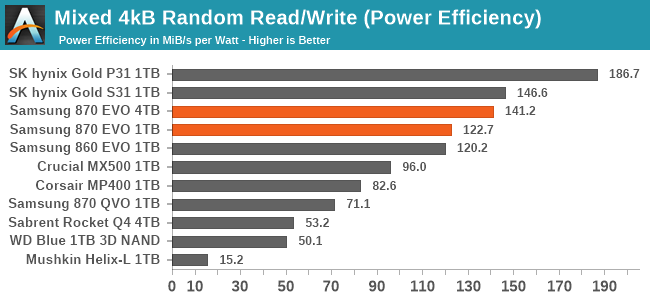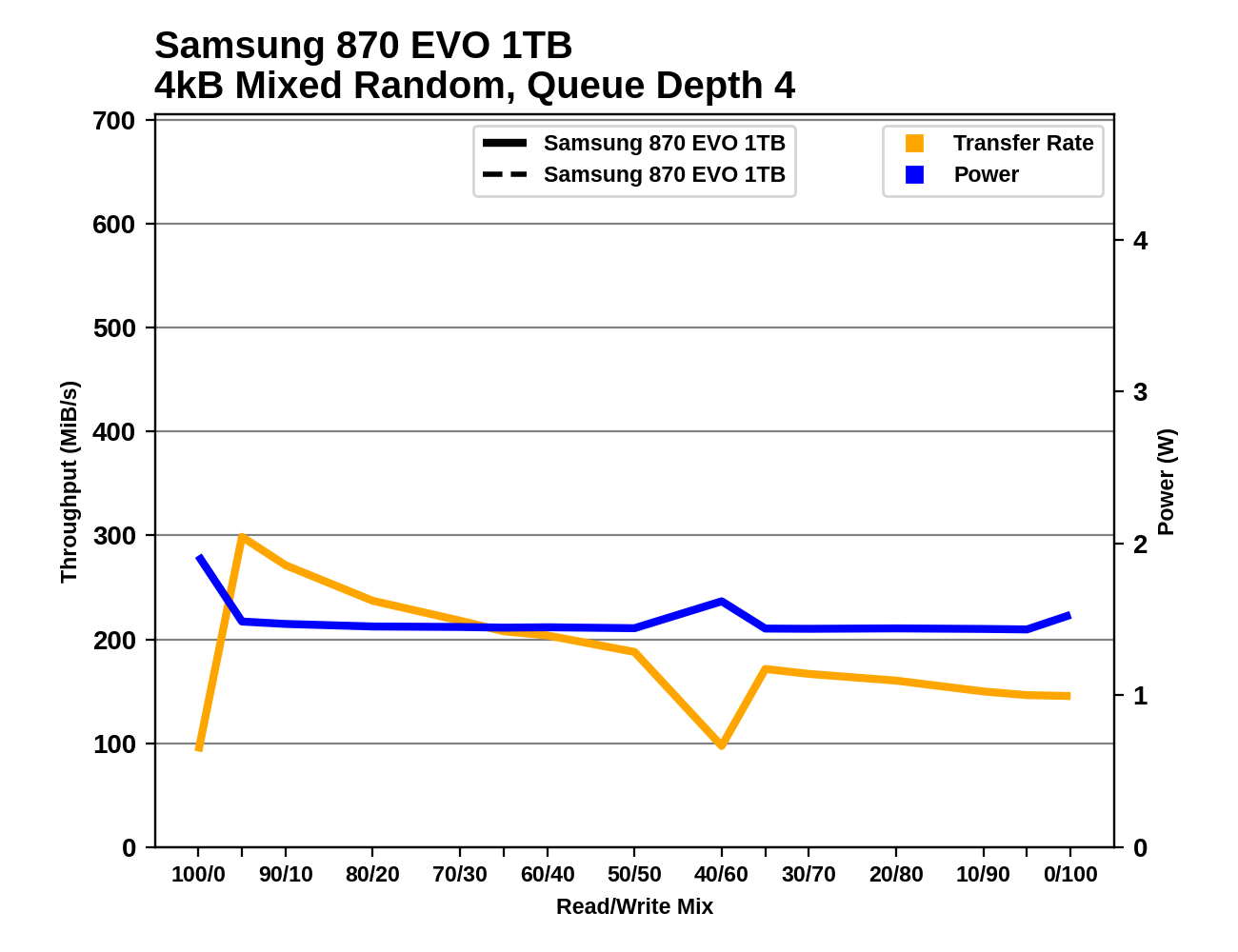The Samsung 870 EVO (1TB & 4TB) Review: Does the World Need Premium SATA SSDs?
by Billy Tallis on February 17, 2021 8:00 AM ESTMixed IO Performance
For details on our mixed IO tests, please see the overview of our 2021 Consumer SSD Benchmark Suite.
 |
|||||||||
| Mixed Random IO | Mixed Sequential IO | ||||||||
The mixed random IO test provides the Samsung 870 EVO with one of its biggest performance wins yet over the rest of the SATA field and the entry-level NVMe competition. But most of that comes from the capacity advantage the 4TB model has over most of these comparison drives; the 1TB 870 EVO is only about 5% faster overall than the 860 EVO. On the mixed sequential IO test, the SATA bottleneck keeps most of the performance scores within a fairly narrow range, and the 1TB 870 EVO's performance is actually a bit of a regression compared to its predecessor.
 |
|||||||||
| Mixed Random IO | Mixed Sequential IO | ||||||||
As with our separate tests of random reads and writes, the top efficiency scores for mixed random IO go to SK hynix, with Samsung's TLC drives turning in the next best scores and having a clear advantage over other competing brands. Over on the sequential IO side of things, the efficiency scores more closely mirror the performance scores, and the 870 EVO doesn't have any real advantage over other mainstream SATA drives.
 |
|||||||||
| Mixed Random IO | |||||||||
| Mixed Sequential IO | |||||||||
The 1TB 870 EVO's performance during the mixed random IO test is more consistent than the 860 EVO's, but still has a few unpleasant drops that aren't present for the 4TB model. On the mixed sequential IO test, the 1TB 870 EVO's performance is actually a bit less consistent than the 860 EVO. But aside from those occasional outliers, the general trend is for the 870 EVO to provide superior random IO performance and link-saturating sequential performance across a wide range of workload mixes.
Idle Power Management
Real-world client storage workloads leave SSDs idle most of the time, so the active power measurements presented earlier in this review only account for a small part of what determines a drive's suitability for battery-powered use. Especially under light use, the power efficiency of a SSD is determined mostly be how well it can save power when idle.
SATA SSDs are tested with SATA link power management disabled to measure their active idle power draw, and with it enabled for the deeper idle power consumption score and the idle wake-up latency test. Our testbed, like any ordinary desktop system, cannot trigger the deepest DevSleep idle state. For more details, please see the overview of our 2021 Consumer SSD Benchmark Suite.


The Samsung 870 EVO may feature an updated controller compared to the 860 EVO, but there's no real difference in idle power consumption, for either active idle or the desktop (non-DevSleep) idle states. Samsung's idle power figures are best in class, with SK hynix offering the only close competition.

The Samsung SATA drives all take about one millisecond to wake up from using SATA link power management. This is higher than several of the other SATA drives, but not really enough to be of much concern for system responsiveness.










136 Comments
View All Comments
Snowleopard3000 - Friday, February 19, 2021 - link
It would be nice to see TLC based 16gb and 32gb SSDs..... look at all that empty space, its not like it is that much more work to do it and it will fit fine.Snowleopard3000 - Friday, February 19, 2021 - link
TB not GBMDD1963 - Friday, February 19, 2021 - link
With my slightly less than 10 TBW typical usage per year based on my 960 EVO, the 4 TB 870 EVO should last me...240 years? :)Oxford Guy - Friday, February 19, 2021 - link
I suppose if you're set on buying a Samsung SATA drive, at least if they're all as bad as the 860 1TB QLC drive that has never been stable in a Zen system.toke - Saturday, February 20, 2021 - link
Isn't SK hynix Gold S31 far better in all graps by a big margin?GeoffreyA - Sunday, February 21, 2021 - link
This will be a silly question no doubt, but is there no way to implement the NVMe protocol over SATA? Or is it not possible circuit-wise and electrically? (I understand that SATA is serial and NVMe is more parallel in nature.) If this could be done, while keeping a legacy mode for older drives, problem solved: the newer interface in the same port, while retaining backwards compatibility. Or would this idea be disastrous?R3Z3N - Friday, February 26, 2021 - link
I really wanted to buy 6 8TB SSDs for my build. Instead I went with 2 PCIE NVME SSDS: 980 Pro 1TB boot drive, Sabrent Rocket 4 Plus 2TB, 4 Sata SSDs in Raid 0 on the mobo, and 6 10TB Exos 3.5 drives in raid 10. I get around 1400MBps read on the Raid 10 and 450MBps write with my Highpoint 3720A HBA. It still is a pain to have to create proxy footage to the NVME drives.... I really really want to replace the HDDs with SSDs sooooo bad.Henry 3 Dogg - Friday, July 9, 2021 - link
"...and power efficiency cannot make big leaps without getting rid of the SATA performance limits."OK, I may be being thick. But that just doesn't seem rational at all.
PushT - Monday, October 18, 2021 - link
"Does the world need premium Sata SSDs?" Every single article, you read the same sentiment, formulated more ore less in the same manner. Do we need Sata ssds ? Yes, we need premium large sized sata ssds, as we have needed premium large size HDDs. Increasingly cheaper bulk storage, with the added benefit of EXTREMELY higher random throughput over HDDs, complying with infrastructures all over the world. What is the point of regurgitating the same cheap one- liner in every single article ?We have all been using NVME for years now, and yes we know its faster, and yes we know it is the future. But have the thermal challenges been solved ? And more interestingly, is the infrastructure around it changing fast enough for Sata to be discontinued ? If Sata was excluded from computer architecture as of now, could the world cope ? Nope. It is and has always been about price versus performace, and as long as we dont see the demise of HDDs I can't imagine why we would see the death of Sata SSDs.
So to the original question: Does the world need premium Sata SSDs ? I think the question is wrong. What the industry is doing is trying to find ways to make cheaper nand that is also just as fast. Price versus performance. 870 Evo is not a premium SSD. It is the commercial sample of experimentation. One final question : Given that PREMIUM ssds will cost you an arm and a leg, would you rather your computer system was a hybrid of nvme/Sata SSD, for ultra fast, large and relatively cheap storage and application - Or would you say a few TBs of the insanely fast and expensive premium NVME at the same price, would solve all your problems ? The answer would be the same for most people in the world. Sorry about the rant but it was a long time coming..
pentaxmx - Thursday, November 25, 2021 - link
interesting. Why the reviewer is disappointed when he found out Crucial MX changed 64 layer to 96 layer? Is 96 layer inferior to 64 layer NAND? Shouldn't that be considered an upgrade???